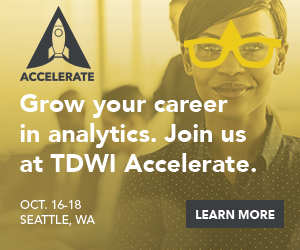Learn the Most Valuable Visualization Skills From Industry’s Best
By Meighan Berberich, President, TDWI

Communication—the process by which information is exchanged between individuals. In the analytics field, we like to call it “data visualization,” but it’s really just a particular form of communication. There’s nothing special about that. Even bacteria can communicate with each other. So why can it be so difficult for data professionals to get their meaning across?
There are few other areas where Art and Science collide in such a head-on way. Effective data visualization requires its practitioners to be constantly threading the needle between the art of the visual (How many colors is too many? Will viewers tune out at another bar chart?) and the science of the numbers. In addition, there can be a lot riding on a visualization’s effectiveness—business opportunities lost, warning signs missed, promising applications abandoned.
As Nick Kelly, vice president of BluLink Solutions, says, “many analytics projects start well intentioned” but are never fully adopted by frontline business users. Though there are a number of potential reasons, he says, Kelly identifies poor user experience as a common one.
Designing With Data
Dave McColgin, executive creative director of Seattle-based design firm Artefact, takes a broader view. “We’re still exploring and experimenting how we use, share, and communicate huge amounts of information,” he says. Artefact’s own website speaks as much about its data and research efforts than its jazzy portfolio pieces—a rarity among design firms.
“The task is to transform complex information into designs that engage people and empower them to act,” McColgin says.
Not to be outdone, Datarella’s Joerg Blumtritt sees even greater potential. “In addition to data storytelling, data journalism, and even simple dashboards, data has grown into a medium for creative output.”
Blumtritt is a co-author of “The Slow Media Manifesto,” which emphasizes choosing one’s media ingredients slowly and with care. “Contemporary artists are still struggling to find the language for their output in the post-internet age. Parametric design, algorithmic architecture, and rapid prototyping technologies have redefined the relationship between creator and artist tools.”
You can catch more from each of these visionaries at TDWI Accelerate Seattle, October 16-18.

 The Data Scientists Guide to User Experience
The Data Scientists Guide to User Experience
Nick Kelly, Vice President, BluLink Solutions
This session takes a practical approach to addressing user experience problems—from strategies such as conducting user interviews at project inception through to the completion of the project and addressing user adoption and sharing of insights.
- Core UX principles to apply to analytics requirements gathering
- How a workshop format can address stakeholder challenges
- Using wire-framing to design the end state
- Key steps to operationalize insights
- Reasons why sharing and gamification matter
 Beyond Visualization: Designing Data For Insights And Action
Beyond Visualization: Designing Data For Insights And Action
Dave McColgin, Executive Creative Director, Artefact
The attendees of this session will take away tangible methods for approaching designing data for people. Dave will share how leading design and innovation consultancy Artefact approaches the design of data visualization and analytics tools, based on a range of desired outcomes and audiences and using examples from award-winning projects like the SIMBA breast cancer decision tool, USAFacts, and more.
 Data Art: Beyond Infographics
Data Art: Beyond Infographics
Joerg Blumtritt, CEO, Datarella
When it comes to data visualizations, we usually think of infographics. However, contemporary artists have been enacting critical examination of technology and its impact on society, such as surveillance and self-determination. This talk takes you to the very edges of what is being done with data in mediums ranging from video, software, and websites to hardware, kinetic machines, and robotics.
View the complete agenda of more than 30 sessions across 3 days.
The time is now. The demand for skills in analytics and data science has reached an all-time high. Everywhere, organizations are building advanced analytics practices to drive business value, improve operations, enrich customer experiences, and so much more.
Build your expertise. Drive your organization’s success. Advance your career. Join us at TDWI Accelerate, October 16-18 in Seattle, WA.